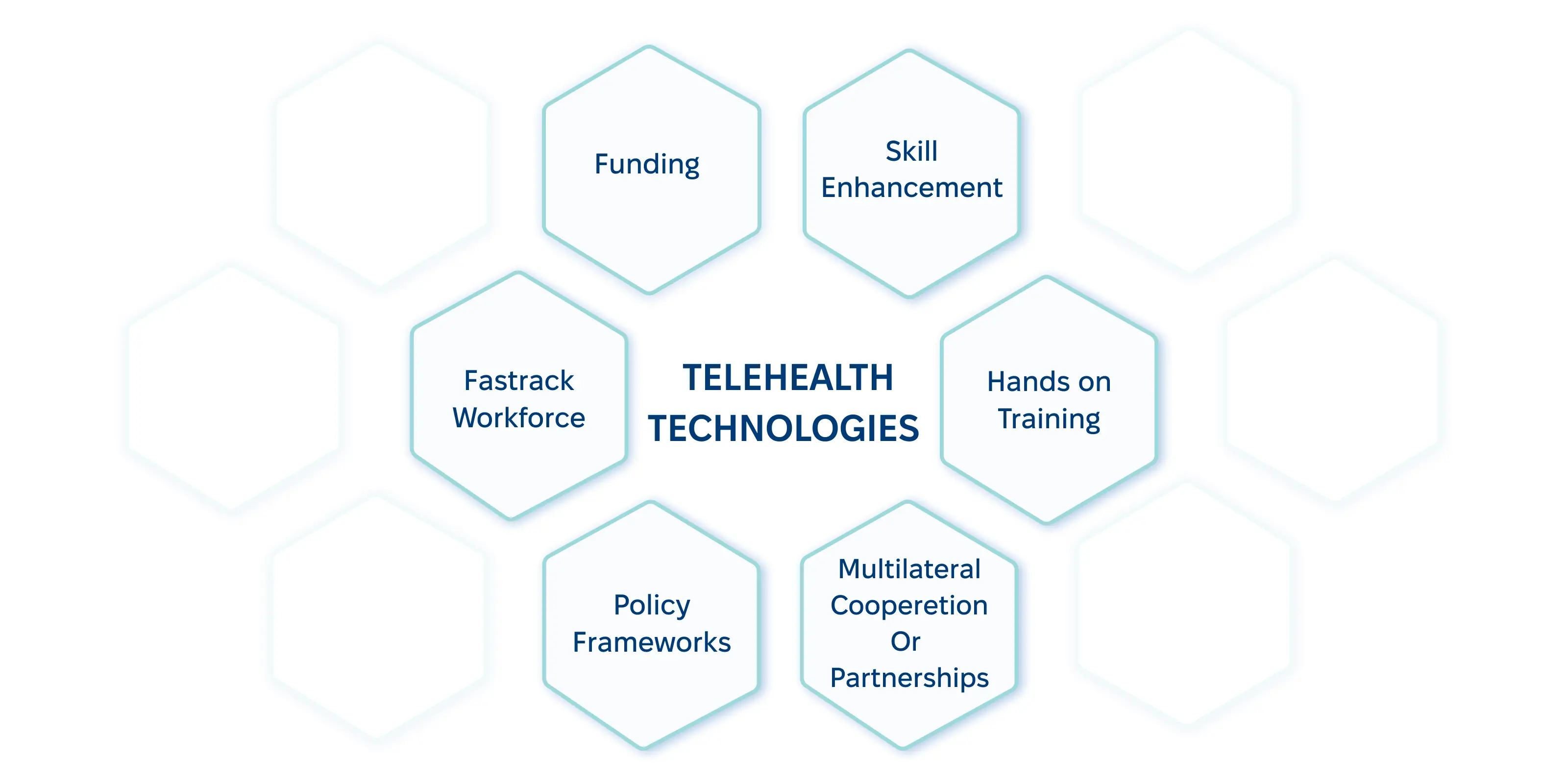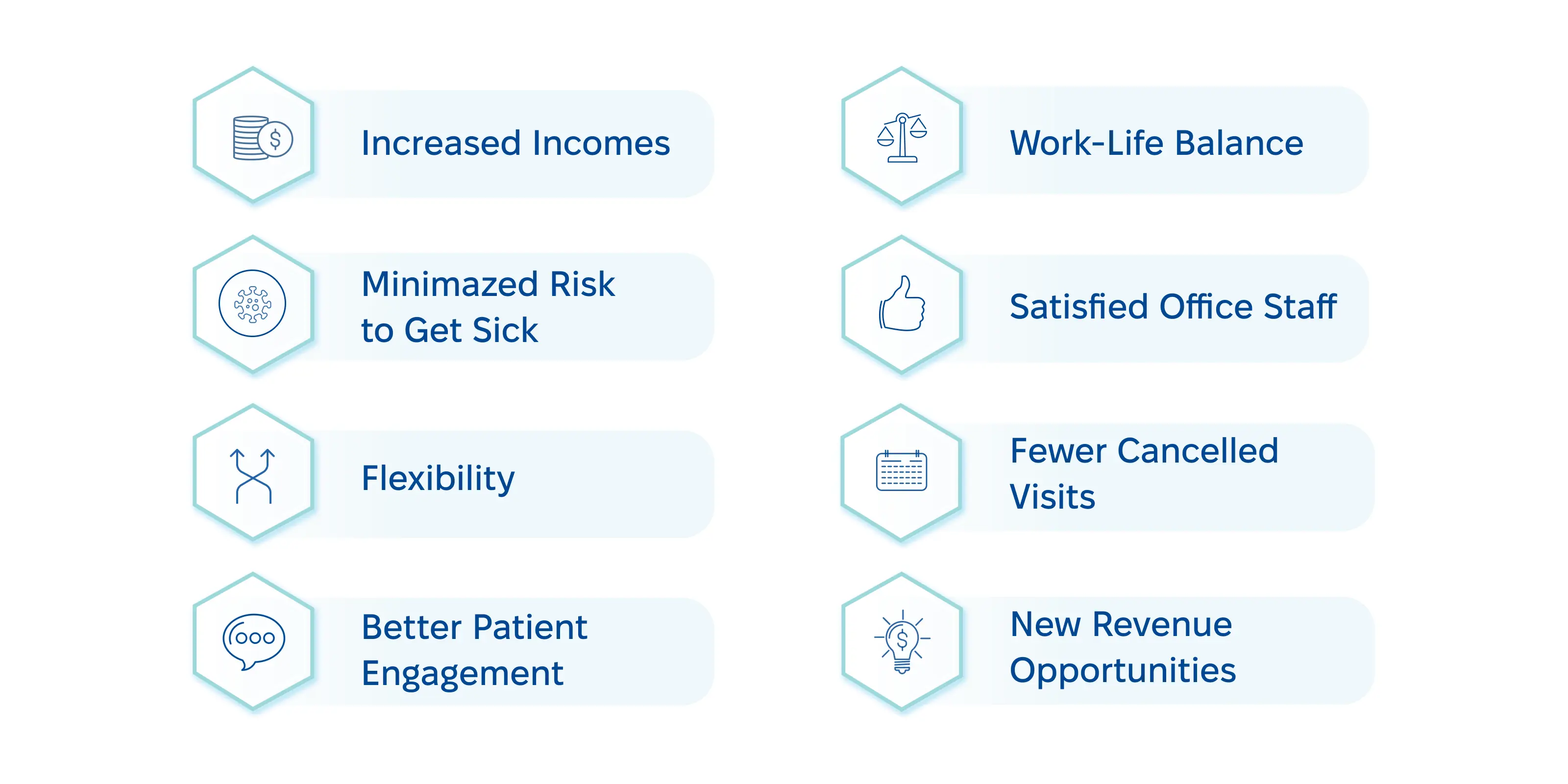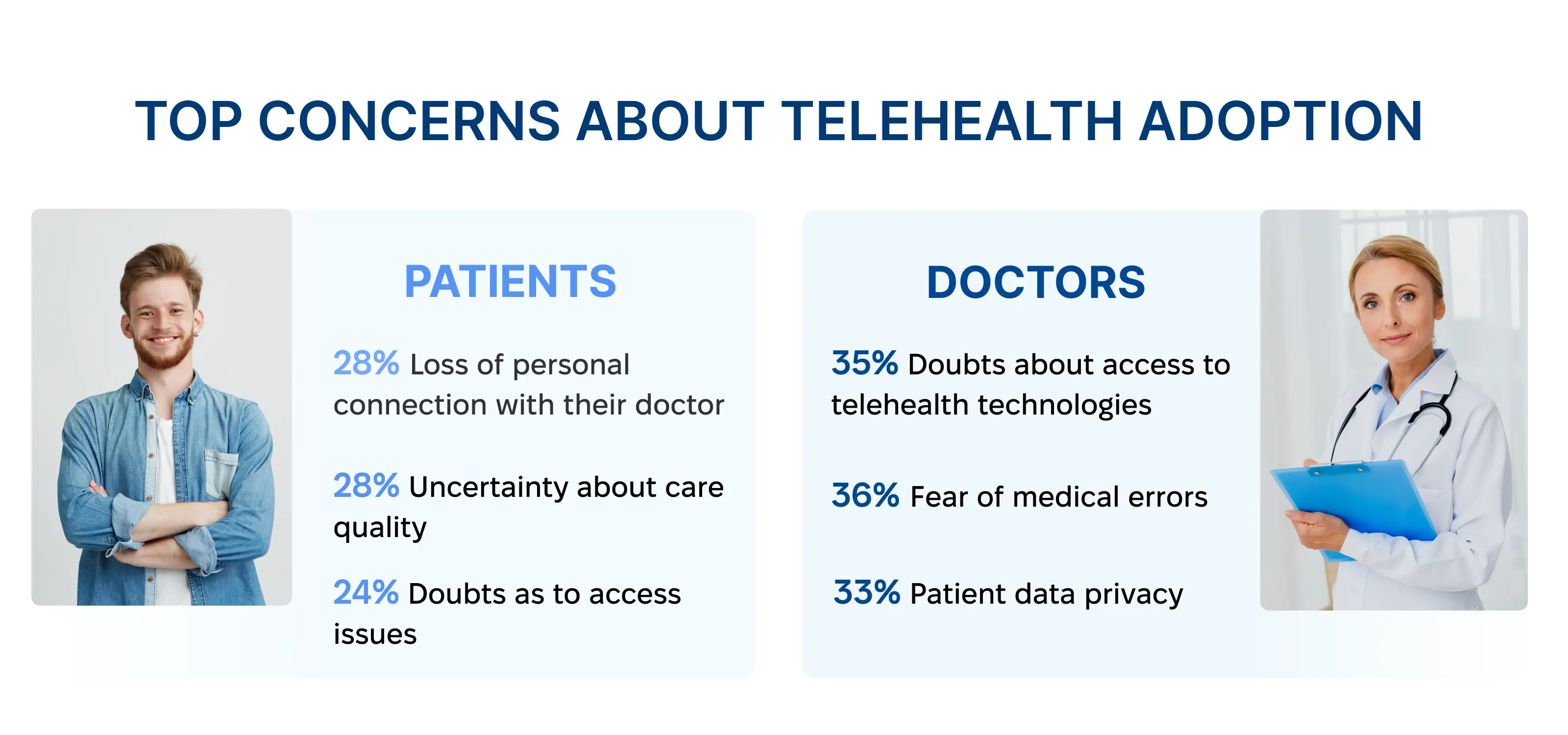A successful telehealth strategy prioritizes clear objectives, user-friendly technology, and compliance with healthcare regulations. It includes patient education, staff training, and continuous quality monitoring, alongside financial planning for sustainable care delivery. We discuss all of these strategy components in greater detail in our blog post.
Using digital tools in healthcare is familiar, as Electronic Medical Records (EMRs) or Electronic Health Records (EHRs) have been here for many years. However, in recent times, the importance of these tools has grown significantly throughout the entire care delivery. As almost everyone now uses smartphones, many patients rely on their phones to find healthcare providers, attend appointments, and communicate with their care team after appointments, increasing their interest in developing the proper telehealth strategy.
At the same time, healthcare organizations should plan to introduce virtual health systems. They should clearly understand what they hope to achieve. Not all telehealth providers offer high-quality services and products. Some may be better for a particular facility, its staff, and patients.
An elaborate
telehealth implementation
is essential. It is needed to create good conditions for providing these medical services. Even experienced facilities may struggle. They need the proper method and tools to include remote tech in their routine. It helps create a good approach to patients. It also cuts healthcare costs by minimizing the prices of transportation and decreasing the of
false ambulance calls.
And for all that, any medical facility like a hospital, clinic, or ambulatory would require a complex telehealth software development service. Exoft is a concentration of the necessary knowledge and experience that can help your service include telehealth to your agenda. Our company can assist you with creating a telehealth implementation strategy that would significantly increase the efficiency of your medical organization.

Why a Hospital Needs A Telehealth Strategy
Telehealth visits enable individuals to receive the remote care they require promptly and conveniently by increasing their access to doctors and specialists. It is a vital tactic for healthcare providers to control patient health from a high-volume, low-cost viewpoint. Telehealth also provides hospitals with several advantages, such as:
Telehealth strategies improve patient care in rural communities, where individuals may reside hundreds of miles from primary care physicians, specialists, or other healthcare providers. Social workers and care managers for chronic diseases may also be unavailable in smaller communities. However, access to adequate telemedicine services can prevent patients from traveling excessively for appropriate care. Telehealth capabilities effectively address these challenges, benefiting patients and healthcare companies alike:
- Patients can receive treatment in their local area without additional risks or expenses.
- Local hospitals can increase offerings and generate more revenue while providing better care management depending on the latest research and best practices.
- Healthcare providers can improve patient engagement and reduce costs by remote monitoring of patients in post-acute care settings or at home.
A virtual care strategy can help manage chronic diseases,as per the Centers for Disease Control and Prevention (CDC). The CDC reports that six out of ten American adults have a chronic disease. An estimated four out of ten have two. So, telehealth can help. It can improve the management of chronic diseases for many people.
Around 75% of the overall expenditure on healthcare in the US is dedicated to treating individuals with chronic illnesses. Such people visit emergency rooms and require hospital admissions more frequently. To prevent hospitalization, healthcare providers implement virtual care strategies that involve continuous patient communication and monitoring. So, a telehealth solution is considered optimal for accomplishing these goals.
A telehealth growth strategy significantly reduces budget expenses. With the implementation of this treatment type, the medical facility can reduce the number of unnecessary visits to the emergency department and the costs of the patients' transportation, which could have been avoided with a simple consultation. Unnecessary transportation costs concern rural areas that could be hard to approach.
Reducing hospital expenses is also connected to reducing readmissions. The facility can save budget on unnecessary readmissions by closely monitoring patients remotely. Then, the patient can be treated at home under close supervision from the physician.
Key Pillars of a Winning Telehealth Strategy
Healthcare facilities can create a telehealth program that ensures their digital transformation and aligns with their patients' priorities to accomplish the desired objectives. Let’s observe some of the key pillars that can significantly increase the efficiency of the telehealth growth strategy implementation.
A HIPAA-Compliant Platform
During the early stages of the pandemic, HIPAA regulations were temporarily eased, enabling telehealth delivery through commonly used consumer-facing platforms. Doctors resorted to platforms.
platforms such as Skype, Google Duo, Facebook Messenger, and FaceTime to provide medical care during the global healthcare emergency. However, concerns regarding physician privacy and security breaches, such as the "Zoombombings," quickly emerged, and once HIPAA regulations, these interim solutions will no longer be feasible.
Easy-to-Use Technology
The most critical factor influencing patients to choose virtual visits is their easy use. Regardless of age, gender, or other demographic factors, patients prefer a straightforward process that does not require them to download or install any new apps or undergo complicated sign-in procedures. To ensure patient adoption and usage, it is essential to choose a telehealth program that is user-friendly and easy to use.
High-Quality Video and Sound Options
Patients expect the same level of quality during virtual appointments as they would during an in-person visit. However technical issues such as dropped calls, pixelated video, frozen screens, and intermittent sound loss can lead to frustrating patient experiences. This negative experience may cause patients to switch to a competitor or abandon telemedicine altogether.
Thus, to ensure the best care, healthcare providers can use unified communications and video conferencing tools that are secure, cost-effective, and user-friendly. It is vital to select a platform with various security and privacy settings and the ability to host multi-person conferences to facilitate communication and coordination among multiple providers.
For example, Zoom Video collaboration ensures efficiency of
HIPAA-compliant telemedicine platform
while maintaining user-friendliness. It achieves this through several safety features, like firewall compatibility, integration with medical devices, 128-bit AES video encryption, and password-protected meetings. With Zoom, you can have the best of both worlds: security and ease of use.
Listings of Telehealth Capabilities
Today, having a successful "digital front door" plan is more important than ever. To make accessing healthcare easier, it is necessary to promote telemedicine software development options across all online platforms where patients may search for care and find their doctors. These platforms include external websites, directories, search engines like Healthgrades, Google, and WebMD, as well as your website's physician directory.
Telehealth Reimbursement
There are recommendations for healthcare facilities to establish a telehealth program that provides reimbursement for its services. This reimbursement can come from Medicaid, Medicare, and commercial or private payers. The facility can receive payment from these companies and organizations for its services. A well-structured digital strategy for telemedicine can help optimize the reimbursement process by ensuring services are properly documented and aligned with payer requirements.
Constant Communication
Patients with chronic conditions require continuous care rather than just one-time treatment. That necessitates ongoing communication and outreach efforts. But the communication between patients and clinicians usually diminishes after discharge, and with limited resources available for practitioners, digital solutions are necessary to offer ongoing care on a large scale.
Some of these solutions may include:
- automated appointment reminders
- tailored outreach for vulnerable patient populations
- platforms for engaging caregivers
- databases of community health resources
- tools for screening social Determinants of health (SDoH)
Healthcare organizations that adopt these solutions can expect to see a return on investment (ROI) in reduced readmissions and hospitalizations and improved patient compliance, satisfaction, and overall health outcomes.
Reputation Integration
Reading online feedback from fellow patients has become crucial to the healthcare journey. With the rise of virtual consultations, patients are more likely to search for affirmation online before visiting a hospital or a specific doctor. To promote your hospital's image, earn people's trust in telemedicine, and meet patient demands, consider using a telehealth platform that enables you to gather reviews quickly within the platform. Doing so can establish a solid reputation to encourage patients to return to your physical facility if needed.
Telehealth Adoption Challenges
There are various
benefits of telehealth for patients.
But, it also has many pitfalls. These should be discovered before using it in any healthcare establishment. In this section, we want to reveal the most common challenges you might face when adopting telehealth into your processes.
- Unavailability for certain parts of clients
.
Despite the convenience, telehealth adoption might not be suitable for all patients without the exception. Many people might not have free access to the necessary digital tools, or the internet. Therefore, this particularity has to be carefully considered before the implementation of telehealth features.
- Challenges with regulations
.
As well as provision of the standard medical procedures telehealth options have to be regulated as well. And that’s when the difficulties come into place. Unfortunately, no established procedure can fit absolutely any case. Different states and countries have different visions on the establishment of that practice. That’s why, it should be considered carefully in each particular case.
- Security concerns.
Working with
sensitive data
is a big problem that can be raised during the telehealth implementation plan in your medical facility.
For that matter, you must create secure channels. They must have reliable security protocols.
These protocols would prevent the breaching of sensitive data. Or it’s failing into unscrupulous hands.
Those are only a few of the challenges. You might face them when trying to add telehealth features to your practice. However, you can easily cope with every pitfall from the list with your cooperation with Exoft and by using the right telehealth adoption strategies tailored to your specific needs.
Exoft as Your Telemedicine Software Development Partner
Telemedicine software development is a complex process that requires precision, experience, and dedication. That and even more you will be able to receive during your partnership with Exoft. With us, you can get detailed telehealth strategy consulting. We will also make a specific plan for the adoption of your healthcare establishment. By choosing our company you receive a service that is experienced in the following:
- Creation of the tailor-made telehealth strategy. Our developers will carefully review your key processes. They will make a plan to add the feature without disrupting current flows. We will make sure to choose the necessary tools, and the best conditions and begin the development process immediately.
- Implementation of telehealth strategy in any medical facility. Whether you are engaged in providing medical solutions via the clinic, laboratory, or hospital, be assured that our experts know how to develop the strategy for adopting remote medicine for your particular business.
- Creation of solutions for any budget. You may be planning to use telehealth at a big company or a startup. In both cases, you can find a suitable funding plan in Exoft. We can deliver a suitable strategy for the telehealth implementation that fit any budget.
Telehealth Strategy As a Key to Success
As with any new venture, expanding telehealth services will have risks and difficulties. Nevertheless, numerous patients and healthcare organizations concur that an efficient telehealth strategy can improve patient outcomes, increase doctors' productivity, better manage time, and improve financial performance.
With that in mind, we can confidentially state that telehealth services are the ultimate breakthrough in medical solutions. Based on some major pillars such as compliance, reliability, technologies, and communication, telehealth has become an upgrade that
facilitates medical solutions
to a new level that has never been seen before.
Ultimately, working together through a team effort involving a healthcare provider, its patients, and different support organizations is crucial to achieving optimal results, especially when it concerns both large and small medical institutions, where a complex approach is essential. It’s crucial to entrust the development of your telehealth features to the experienced team of professionals.
And that’s what you are going to get with Exoft. By turning your attention to our company your medical establishment would be able to unlock the perspective of the
telehealth strategy for your project.
Frequently asked questions
How can a patient-centric approach boost my telehealth strategy?
Telegraph implementation a great way of engaging new customers to your facility, as well as increasing the levels of customer satisfaction. This approach will also significantly boost appointment adherence, and distinguish your facility from the various competitors.
Which performance metrics should I focus on to drive financial success in my telehealth practice?
Many performance metrics should be used for evaluation and increase of your financial success. First, we can name customer satisfaction rates. Also, we can name appointment adherence, cancellation rates, and conversion rates. We can also name average revenue numbers.
What are the essential components of successful telehealth integration?
First of all, as a medical provider, you have to draw your attention to the following components. For instance, we can name several key areas. They are tech infrastructure, workflow, and engagement. Then there's communication and reputation integration.
Are there any risks in the implementation of telehealth in medical facilities?
There are several risks that any medical facility may face during the implementation of the telehealth feature. Firstly, it’s the digital unavailability of certain patterns that can deprive them of using this kind of service. Next, there are problems with the legal rules for telehealth. Also, there are ethical and security issues with sensitive medical data.



